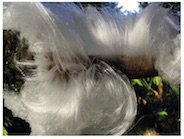lordmongrove
Antediluvian
- Joined
- May 30, 2009
- Messages
- 5,105
The radiation eating fungi of Chernobyl https://www.foxnews.com/science/che...6dnbPQCEdKx6ImXPDY4oZaOf5Rcr-CIx161LO9349OnYs
The radiation eating fungi of Chernobyl https://www.foxnews.com/science/che...6dnbPQCEdKx6ImXPDY4oZaOf5Rcr-CIx161LO9349OnYs
That's the sort of thing usually reserved for sci-fi.Australian fungi grow bigger and faster by processing gold ... Huh? ...
SOURCE: https://www.the-scientist.com/news-opinion/fungus-found-in-australian-soil-can-oxidize-gold-65933
PUBLISHED PAPER: https://www.nature.com/articles/s41467-019-10006-5
Not all fungi are funny ... Some can seriously f**k up other organisms ...
SOURCE: https://www.nytimes.com/2019/06/28/science/cicadas-fungus-butts.html
I wonder if maybe it's an external stimuli and not internal anything?And while posting the mushroom pics on Twitter I saw this: pulsating luminous mycelium:

My favorite Czech mycologist has found some really strange fungi:

Jehnědka červenohnědá (Ciboria rufofusca) - growing under pine trees ... #mushroomsgivehappiness [Inedible]
It's real! Unbelievable I never saw it in a mushroom book:
https://en.m.wikipedia.org/wiki/Ileodictyon_cibarium
Lets see some of those plants function without the fungi though! So in terms of importance fungi clearly win.The carbonaceous winners are plants, which make up about 80 percent of all biomass on Earth. Bacteria comes in second at 13 percent and fungus is third at just 2 percent.
Of the 550 gigatons of biomass carbon on Earth, animals make up about 2 gigatons, with insects comprising half of that and fish taking up another 0.7 gigatons. Everything else, including mammals, birds, nematodes and mollusks are roughly 0.3 gigatons, with humans weighing in at 0.06 gigatons. The research appears in The Proceedings of the National Academy of Sciences.
“The fact that the biomass of fungi exceeds that of all animals’ sort of puts us in our place,” Harvard evolutionary biologist James Hanken, who was not involved with the study, tells Borenstein.
FULL STORY: http://www.southbendtribune.com/new...cle_60c6c146-b4e8-11eb-9046-c32f2959461d.htmlFungus full of psychedelic drugs could cause Indiana Brood X cicadas' butts to fall off

It sounds like a twisted mix of “Invasion of the Body Snatchers” and a Grateful Dead show. But John Lill promises that it’s all too real.
This month, as billions of Brood X cicadas emerge from the dirt in Indiana and more than a dozen other states for the first time in 17 years, some of the bugs will suffer a horrific, science-fiction-like fate. There’s no delicate way to do this, so here’s the gist all at once.
A fungus laced with the same chemical as psychedelic mushrooms will invade their bodies and eat away their insides until their abdomens crack, fall off and get replaced with a ball of white spores. Because they’re either bombed on psilocybin or under the control of the fungus in some other way, the cicadas won’t even notice. With missing butts and full hearts, they’ll forge ahead with their only reason for existing: finding a mate and reproducing.
Of course, that last part will be impossible with half their body rotted away.
“Really what they’re doing is spreading these spores all over the place,” said Lill, a cicada expert and chair of biology at George Washington University. “It’s a sexually transmitted fungus. They engage in normal courtship behavior, yet their abdomen is a big fungal mass. Instead, the attempted copulation results in spreading the fungus even more.”
Called Massospora cicadina, the fungus can inflict both males and females. ...
As PBS’ Anna Rothschild argued in an episode of “Gross Science,” a little empathy wouldn’t hurt.
“Imagine if, after a lifetime underground, you only had a few glorious weeks to live in the sun, eat and mate,” she said. “And then your butt fell off.”
Sorry. The tree is standing up, it’s the photo that’s laying down.Would our resident Fungi expert be able to enlighten me on this particular specimen that has recently appeared on our morning walk. And would it be safe to consume for breakfast?
From that shot it looks like Laetiporus sulphureus, the sulphur bracket. Personally I’m not going to comment on edibility, particularly from a photograph. What I will say is if you don’t know 100% what it is don’t eat it.Would our resident Fungi expert be able to enlighten me on this particular specimen that has recently appeared on our morning walk. And would it be safe to consume for breakfast?
